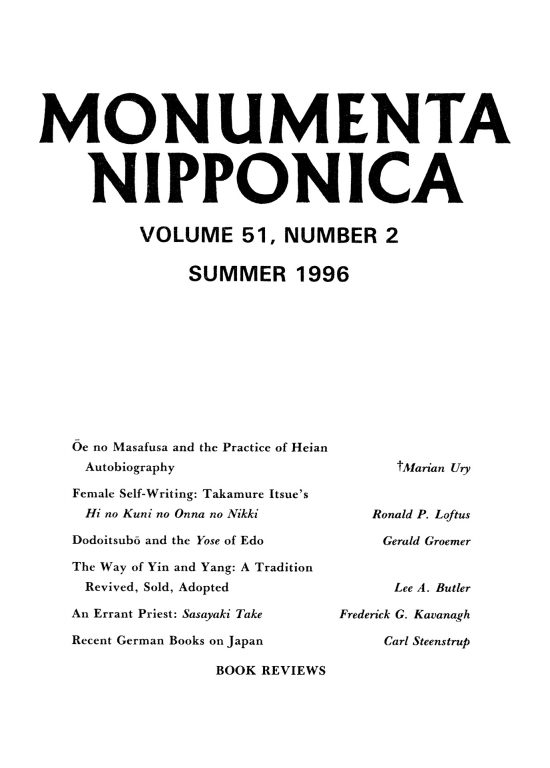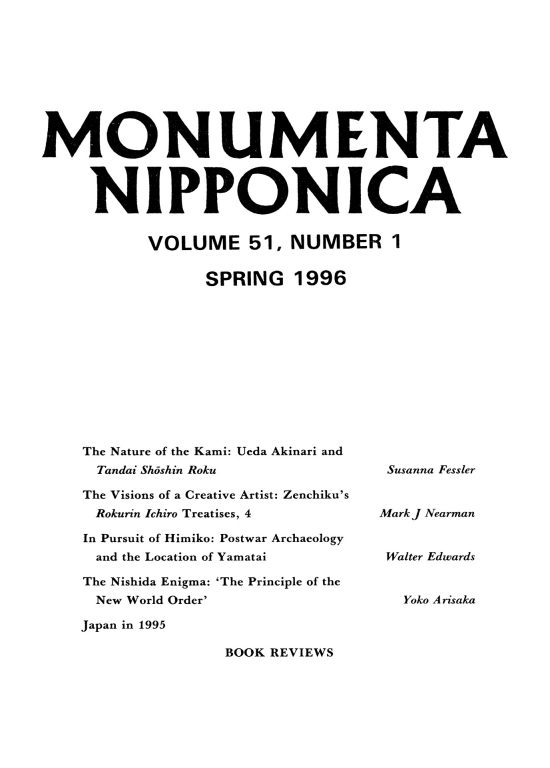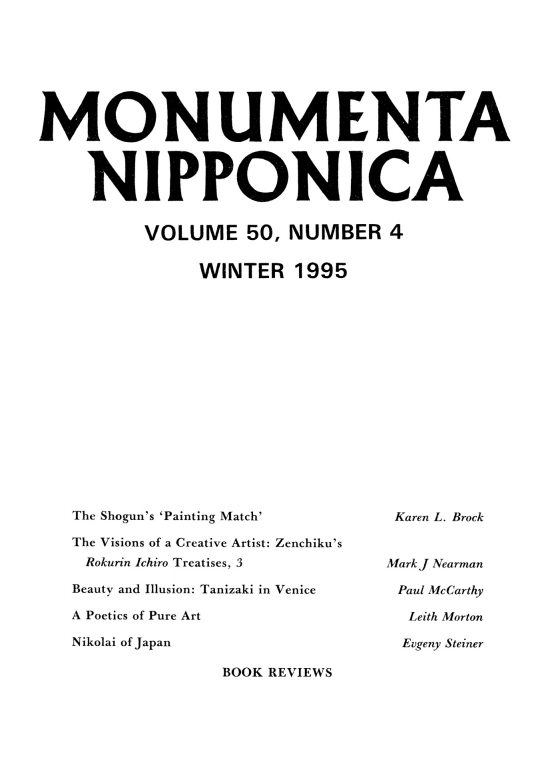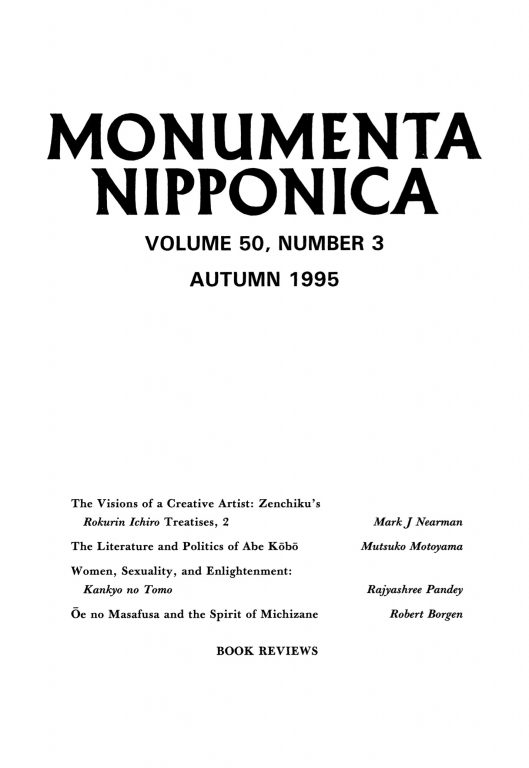Founded in 1938 and published semiannually by Sophia University MN 51:2 (1996) 225–44The Whispering BambooTranslated by Frederick G. Kavanagh
MN 51:2 (1996) 225–44The Whispering BambooTranslated by Frederick G. Kavanagh MN 51:2 (1996) 245–56Recent German Books on JapanCarl Steenstrup
MN 51:2 (1996) 245–56Recent German Books on JapanCarl Steenstrup MN 51:2 (1996) 257–59Ikki: Social Conflict and Political Protest in Early Modern Japan by James W. WhiteAnne Walthall
MN 51:2 (1996) 257–59Ikki: Social Conflict and Political Protest in Early Modern Japan by James W. WhiteAnne Walthall MN 51:2 (1996) 259–61Japan Encounters the Barbarian: Japanese Travellers in America and Europe by W. G. BeasleyRoy S. Hanashiro
MN 51:2 (1996) 259–61Japan Encounters the Barbarian: Japanese Travellers in America and Europe by W. G. BeasleyRoy S. Hanashiro MN 51:2 (1996) 262–63Saigō Takamori: The Man Behind the Myth by Charles L. YatesSidney DeVere Brown
MN 51:2 (1996) 262–63Saigō Takamori: The Man Behind the Myth by Charles L. YatesSidney DeVere Brown MN 51:2 (1996) 263–65Principle, Praxis, and the Politics of Educational Reform in Meiji Japan by Mark E. LincicomeDonald Roden
MN 51:2 (1996) 263–65Principle, Praxis, and the Politics of Educational Reform in Meiji Japan by Mark E. LincicomeDonald Roden MN 51:2 (1996) 265–68Wind in the Pines: Classic Writings of the Way of Tea as a Buddhist Path by Dennis HirotaTheodore M. Ludwig
MN 51:2 (1996) 265–68Wind in the Pines: Classic Writings of the Way of Tea as a Buddhist Path by Dennis HirotaTheodore M. Ludwig MN 51:2 (1996) 268–70The Passionate Art of Kitagawa Utamaro by Shūgō Asano, Timothy ClarkDonald Jenkins
MN 51:2 (1996) 268–70The Passionate Art of Kitagawa Utamaro by Shūgō Asano, Timothy ClarkDonald Jenkins MN 51:2 (1996) 270–72Lacquerware from the Weston Collection: A Selection of Inro and Boxes by Julia MeechHugh Wylie
MN 51:2 (1996) 270–72Lacquerware from the Weston Collection: A Selection of Inro and Boxes by Julia MeechHugh Wylie MN 51:2 (1996) 273–75Discourses of the Vanishing: Modernity, Phantasm, Japan by Marilyn IvyEyal Ben-Ari
MN 51:2 (1996) 273–75Discourses of the Vanishing: Modernity, Phantasm, Japan by Marilyn IvyEyal Ben-Ari MN 51:2 (1996) 276–77Textiles and Industrial Transition in Japan by Dennis L. McNamaraBarbara Molony
MN 51:2 (1996) 276–77Textiles and Industrial Transition in Japan by Dennis L. McNamaraBarbara Molony MN 51:1 (1996) 1–15The Nature of the Kami: Ueda Akinari and Tandai Shōshin RokuSusanna Fessler
MN 51:1 (1996) 1–15The Nature of the Kami: Ueda Akinari and Tandai Shōshin RokuSusanna Fessler MN 51:1 (1996) 8–15Selections from Tandai Shōshin RokuAkinari Ueda, Translated by Susanna Fessler
MN 51:1 (1996) 8–15Selections from Tandai Shōshin RokuAkinari Ueda, Translated by Susanna Fessler MN 51:1 (1996) 17–52The Visions of a Creative Artist: Zenchiku’s Rokurin Ichiro Treatises (Part 4)Zenchiku, Translated by Mark J. Nearman
MN 51:1 (1996) 17–52The Visions of a Creative Artist: Zenchiku’s Rokurin Ichiro Treatises (Part 4)Zenchiku, Translated by Mark J. Nearman MN 51:1 (1996) 53–79In Pursuit of Himiko: Postwar Archaeology and the Location of YamataiWalter Edwards
MN 51:1 (1996) 53–79In Pursuit of Himiko: Postwar Archaeology and the Location of YamataiWalter Edwards MN 51:1 (1996) 81–105The Nishida Enigma: ‘The Principle of the New World Order’Yoko Arisaka
MN 51:1 (1996) 81–105The Nishida Enigma: ‘The Principle of the New World Order’Yoko Arisaka MN 51:1 (1996) 100–105The Principle of the New World Order: Sekai Shin-Chitsujo no GenriNishida Kitarō, Translated by Yoko Arisaka
MN 51:1 (1996) 100–105The Principle of the New World Order: Sekai Shin-Chitsujo no GenriNishida Kitarō, Translated by Yoko Arisaka MN 51:1 (1996) 107–20Japan in 1995
MN 51:1 (1996) 107–20Japan in 1995 MN 51:1 (1996) 121–23Breaking Barriers: Travel and the State in Early Modern Japan by Constantine Nomikos VaporisLuke S. Roberts
MN 51:1 (1996) 121–23Breaking Barriers: Travel and the State in Early Modern Japan by Constantine Nomikos VaporisLuke S. Roberts MN 51:1 (1996) 123–25Motoori Norinaga’s ‘The Two Shrines of Ise: An Essay of Split Bamboo’ by Mark TeeuwenJohn Allen Tucker
MN 51:1 (1996) 123–25Motoori Norinaga’s ‘The Two Shrines of Ise: An Essay of Split Bamboo’ by Mark TeeuwenJohn Allen Tucker MN 51:1 (1996) 125–27Learning To Be Modern: Japanese Political Discourse on Education by Byron K. MarshallEdward R. Beauchamp
MN 51:1 (1996) 125–27Learning To Be Modern: Japanese Political Discourse on Education by Byron K. MarshallEdward R. Beauchamp MN 51:1 (1996) 128–30Neighborhood and Nation in Tokyo, 1905–1937 by Sally Ann HastingsStephen S. Large
MN 51:1 (1996) 128–30Neighborhood and Nation in Tokyo, 1905–1937 by Sally Ann HastingsStephen S. Large MN 51:1 (1996) 130–33Japan in Traditional and Postmodern Perspectives by Charles Weihsun Fu, Steven HeineJamie Hubbard
MN 51:1 (1996) 130–33Japan in Traditional and Postmodern Perspectives by Charles Weihsun Fu, Steven HeineJamie Hubbard MN 51:1 (1996) 134–36The Frank Lloyd Wright Collection of Surimono by Joan B. Mirviss, John T. CarpenterMatthi Forrer
MN 51:1 (1996) 134–36The Frank Lloyd Wright Collection of Surimono by Joan B. Mirviss, John T. CarpenterMatthi Forrer MN 51:1 (1996) 136–39Ceremony and Ritual in Japan: Religious Practices in an Industralized Society by Jan van Bremen, D. P. MartinezDavid W. Plath
MN 51:1 (1996) 136–39Ceremony and Ritual in Japan: Religious Practices in an Industralized Society by Jan van Bremen, D. P. MartinezDavid W. Plath MN 51:1 (1996) 139–41Japanese Workers in Protest: An Ethnography of Consciousness and Experience by Christena L. TurnerAndrew Gordon
MN 51:1 (1996) 139–41Japanese Workers in Protest: An Ethnography of Consciousness and Experience by Christena L. TurnerAndrew Gordon MN 50:4 (1995) 433–84The Shogun’s ‘Painting Match’Karen L. Brock
MN 50:4 (1995) 433–84The Shogun’s ‘Painting Match’Karen L. Brock MN 50:4 (1995) 485–521The Visions of a Creative Artist: Zenchiku’s Rokurin Ichiro Treatises (Part 3)Zenchiku, Translated by Mark J. Nearman
MN 50:4 (1995) 485–521The Visions of a Creative Artist: Zenchiku’s Rokurin Ichiro Treatises (Part 3)Zenchiku, Translated by Mark J. Nearman MN 50:4 (1995) 523–528Beauty and Illusion: Tanizaki in VenicePaul McCarthy
MN 50:4 (1995) 523–528Beauty and Illusion: Tanizaki in VenicePaul McCarthy MN 50:4 (1995) 529–535A Poetics of Pure ArtLeith Morton
MN 50:4 (1995) 529–535A Poetics of Pure ArtLeith Morton MN 50:4 (1995) 537–550Nikolai of JapanEvgeny Steiner
MN 50:4 (1995) 537–550Nikolai of JapanEvgeny Steiner MN 50:4 (1995) 551–553Dreams of Difference: The Japan Romantic School and the Crisis of Modernity by Kevin Michael DoakPaul Anderer
MN 50:4 (1995) 551–553Dreams of Difference: The Japan Romantic School and the Crisis of Modernity by Kevin Michael DoakPaul Anderer MN 50:4 (1995) 553–555La pensée de Kobayashi Hideo: Un intellectuel japonais au tournant de l’histoire by Ninomiya MasayukiRoy Starrs
MN 50:4 (1995) 553–555La pensée de Kobayashi Hideo: Un intellectuel japonais au tournant de l’histoire by Ninomiya MasayukiRoy Starrs MN 50:4 (1995) 555–558A Guide to Ezra Pound and Ernest Fenollosa’s ‘Classic Noh Theatre of Japan’ by Akiko Miyake, Sanehide Kodama, Nicholas TeeleEileen Katō
MN 50:4 (1995) 555–558A Guide to Ezra Pound and Ernest Fenollosa’s ‘Classic Noh Theatre of Japan’ by Akiko Miyake, Sanehide Kodama, Nicholas TeeleEileen Katō MN 50:4 (1995) 558–560Documentos del Japón, 1547–1557 by Juan Ruiz-de-Medina; Documentos del Japón, 1558–1562 by Juan Ruiz-de-MedinaMichael Cooper
MN 50:4 (1995) 558–560Documentos del Japón, 1547–1557 by Juan Ruiz-de-Medina; Documentos del Japón, 1558–1562 by Juan Ruiz-de-MedinaMichael Cooper MN 50:4 (1995) 560–562The Taming of the Samurai: Honorific Individualism and the Making of Modern Japan by Eiko IkegamiH. Paul Varley
MN 50:4 (1995) 560–562The Taming of the Samurai: Honorific Individualism and the Making of Modern Japan by Eiko IkegamiH. Paul Varley MN 50:4 (1995) 562–566Central Authority and Local Autonomy in the Formation of Early Modern Japan: The Case of Kaga Domain by Philip C. BrownRonald P. Toby
MN 50:4 (1995) 562–566Central Authority and Local Autonomy in the Formation of Early Modern Japan: The Case of Kaga Domain by Philip C. BrownRonald P. Toby MN 50:4 (1995) 566–569The Making of a Japanese Periphery, 1750–1920 by Kären WigenNeil L. Waters
MN 50:4 (1995) 566–569The Making of a Japanese Periphery, 1750–1920 by Kären WigenNeil L. Waters MN 50:4 (1995) 569–572Edo and Paris: Urban Life and the State in the Early Modern Era by James L. McClain, John M. Merriman, Ugawa KaoruPaul Waley
MN 50:4 (1995) 569–572Edo and Paris: Urban Life and the State in the Early Modern Era by James L. McClain, John M. Merriman, Ugawa KaoruPaul Waley MN 50:4 (1995) 572–574Capitalism From Within: Economy, Society, and the State in a Japanese Fishery by David L. HowellBrett L. Walker
MN 50:4 (1995) 572–574Capitalism From Within: Economy, Society, and the State in a Japanese Fishery by David L. HowellBrett L. Walker MN 50:4 (1995) 574–576Nitobe Inazō: Japan’s Bridge Across the Pacific by John HowesSally Ann Hastings
MN 50:4 (1995) 574–576Nitobe Inazō: Japan’s Bridge Across the Pacific by John HowesSally Ann Hastings MN 50:4 (1995) 577–579Architects of Affluence: The Tsutsumi Family and the Seibu Enterprises in 20th-Century Japan by Thomas R. H. HavensGary D. Allinson
MN 50:4 (1995) 577–579Architects of Affluence: The Tsutsumi Family and the Seibu Enterprises in 20th-Century Japan by Thomas R. H. HavensGary D. Allinson MN 50:4 (1995) 579–581Haiga: Takebe Sōchō and the Haiku-Painting Tradition by Stephen AddissJoan H. O'Mara
MN 50:4 (1995) 579–581Haiga: Takebe Sōchō and the Haiku-Painting Tradition by Stephen AddissJoan H. O'Mara MN 50:4 (1995) 581–583An American in Japan, 1945–1948: A Civilian View of the Occupation by Jacob Van StaaverenGary DeCoker
MN 50:4 (1995) 581–583An American in Japan, 1945–1948: A Civilian View of the Occupation by Jacob Van StaaverenGary DeCoker MN 50:4 (1995) 583–586Japanese New Religions in the West by Peter B. Clarke, Jeffrey SomersRichard Fox Young
MN 50:4 (1995) 583–586Japanese New Religions in the West by Peter B. Clarke, Jeffrey SomersRichard Fox Young MN 50:4 (1995) 586–590Les Mathématiques japonaises à l’époque d’Edo (1600–1868): Une étude des travaux de Seki Takakazu (?–1708) et de Takebe Katahiro (1664–1739) by Annick HoriuchiDénes Nagy
MN 50:4 (1995) 586–590Les Mathématiques japonaises à l’époque d’Edo (1600–1868): Une étude des travaux de Seki Takakazu (?–1708) et de Takebe Katahiro (1664–1739) by Annick HoriuchiDénes Nagy MN 50:3 (1995) 281–303The Visions of a Creative Artist: Zenchiku’s Rokurin Ichiro Treatises (Part 2)Zenchiku, Translated by Mark J. Nearman
MN 50:3 (1995) 281–303The Visions of a Creative Artist: Zenchiku’s Rokurin Ichiro Treatises (Part 2)Zenchiku, Translated by Mark J. Nearman MN 50:3 (1995) 305–23The Literature and Politics of Abe Kōbō: Farewell to Communism in Suna no OnnaMutsuko Motoyama
MN 50:3 (1995) 305–23The Literature and Politics of Abe Kōbō: Farewell to Communism in Suna no OnnaMutsuko Motoyama



